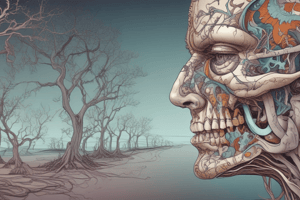Podcast
Questions and Answers
Cervical extension/rotation Muscle adaptations: - poor performance of ______ or serratus
Cervical extension/rotation Muscle adaptations: - poor performance of ______ or serratus
traps
Short/stiff ______ minor, lats
Short/stiff ______ minor, lats
pec
Insufficient rib cage ______
Insufficient rib cage ______
expansion
Short/stiff neck musculature esp ______, suboccipital or levator
Short/stiff neck musculature esp ______, suboccipital or levator
______ may reveal cervical rib, DJD of the spine, malunion of clavicle fx
______ may reveal cervical rib, DJD of the spine, malunion of clavicle fx
Neurogenic Thoracic Outlet Syndrome (TOS) refers to patients with known anomaly in the cervicobrachial region and complaints are mainly ______ weakness.
Neurogenic Thoracic Outlet Syndrome (TOS) refers to patients with known anomaly in the cervicobrachial region and complaints are mainly ______ weakness.
Patients with neurogenic TOS commonly experience parasthesias and/or pain in the upper extremity, commonly down the medial arm and ______.
Patients with neurogenic TOS commonly experience parasthesias and/or pain in the upper extremity, commonly down the medial arm and ______.
The most common type of TOS is the ______ TOS, which is often just referred to as TOS.
The most common type of TOS is the ______ TOS, which is often just referred to as TOS.
Patients with TOS may complain of dropping things and experiencing arm or hand ______.
Patients with TOS may complain of dropping things and experiencing arm or hand ______.
The ______ TOS refers to patients with a known anomaly in the cervicobrachial region and complaints are mainly distal weakness.
The ______ TOS refers to patients with a known anomaly in the cervicobrachial region and complaints are mainly distal weakness.
Match the following symptoms with the corresponding health condition:
Match the following symptoms with the corresponding health condition:
Match the following tests with the corresponding health condition:
Match the following tests with the corresponding health condition:
Match the following movement impairments with the corresponding health condition:
Match the following movement impairments with the corresponding health condition:
Match the following alignment impairments with the corresponding health condition:
Match the following alignment impairments with the corresponding health condition:
Match the following onset characteristics with the corresponding health condition:
Match the following onset characteristics with the corresponding health condition:
Match the muscle adaptations with their descriptions:
Match the muscle adaptations with their descriptions:
Match the potential medical diagnoses requiring referral with their related symptoms:
Match the potential medical diagnoses requiring referral with their related symptoms:
Match the treatment methods with their corresponding descriptions:
Match the treatment methods with their corresponding descriptions:
Match the associated movement impairment diagnoses with their potential sources of symptoms:
Match the associated movement impairment diagnoses with their potential sources of symptoms:
Match the post-operative therapy goals with their corresponding methods:
Match the post-operative therapy goals with their corresponding methods:




